LamiDesign IBU Building System - an advance look
Our first graphical demonstration of our modular system for creating IBU based houses.
Earlier this year we created a multi-unit housing proposal based on 40ft IBU units for a design competition. The images and competition boards were posted in the blog here. At that time we explained that the system shown in the competition entry is the same system of modular parts that would enable larger housing units. We have been hard at work formulating and extending the design of the system to that end and we want to take this opportunity to introduce how it is going to work.
The basic approach is to create large open plan living spaces defined by servant space in load carrying IBUs at the perimeter. In this way activities that can tolerate the rather narrow space of the IBU make best use of the space they provide - sleeping, bathing, kitchen work space, and the resultant open space between them provides natural relief from the smaller spaces and comfortable and flexible living space.
Now the system is not a series of house designs per-se, but rather a series of modular building blocks that will fit interchangeably into a general house schema. To demonstrate I've developed a house plan based on a 3 box schema. This was chosen because I've shown sketches of this configuration before, once in my essay about IBUs, and a 2 box variation in a multi unit stack in another post, a two story configuration of this house scheme was also used in one of my modern house cartoons. It was also chosen because it makes a small, compact, yet very livable modern floor plan. A good starter home, or weekender for those in a position to have one. It is also suitable for multi unit buildings as well. It seemed like a good place to start.
Here is the floor plan of a basic 3 box schema. It contains 3 bedrooms, two full baths, kitchen, and open living room. This house nets out at just over 1000 sqft.
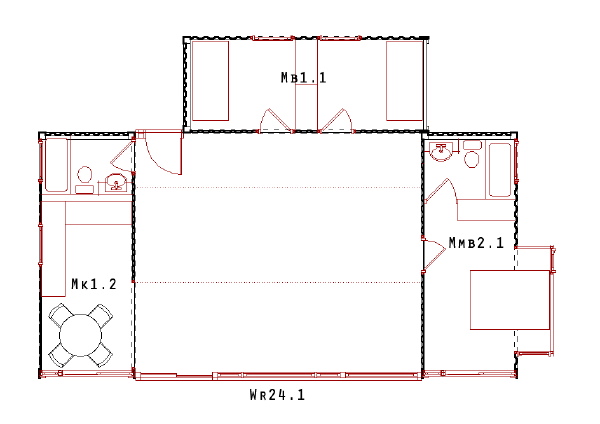
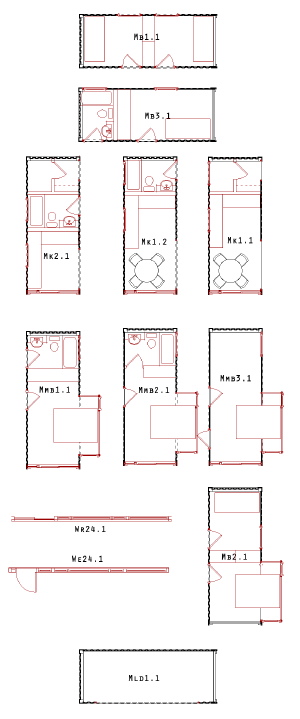 The bedrooms are very small by today's standards. The bathrooms are as well - 5x7s as they are known in the industry. Yet the living room at 20ft by 24ft is larger than what is offered in many larger homes. This small house will live larger than its size no doubt, but the proximity of living space to bedrooms will not allow you to escape the fact it is a small home.
But this one layout is only the start. We intend to offer a small range of modules with slightly different configurations in order to allow you to find a combination that best suits your needs. In the image you can see there are 3 different Kitchen modules shown, and 3 different Master Bedroom modules, and 3 different modules for secondary bedrooms. These units can be plugged and played to create new variations on the floor plan, albeit subtle variations. However 2 box variations on the schema are possible for even smaller 1 or 2 bedroom homes, or 4 box variations which can create 4 or 5 bedroom homes.
The depth of variation that these modules introduces grows quite quickly. Below we have shown 16 floor plan variations of the 24 which we quickly came up with. I am sure there are many more that have not occurred to us yet. We expect our customers to surprise us with the variations they bring to the table.
The bedrooms are very small by today's standards. The bathrooms are as well - 5x7s as they are known in the industry. Yet the living room at 20ft by 24ft is larger than what is offered in many larger homes. This small house will live larger than its size no doubt, but the proximity of living space to bedrooms will not allow you to escape the fact it is a small home.
But this one layout is only the start. We intend to offer a small range of modules with slightly different configurations in order to allow you to find a combination that best suits your needs. In the image you can see there are 3 different Kitchen modules shown, and 3 different Master Bedroom modules, and 3 different modules for secondary bedrooms. These units can be plugged and played to create new variations on the floor plan, albeit subtle variations. However 2 box variations on the schema are possible for even smaller 1 or 2 bedroom homes, or 4 box variations which can create 4 or 5 bedroom homes.
The depth of variation that these modules introduces grows quite quickly. Below we have shown 16 floor plan variations of the 24 which we quickly came up with. I am sure there are many more that have not occurred to us yet. We expect our customers to surprise us with the variations they bring to the table.
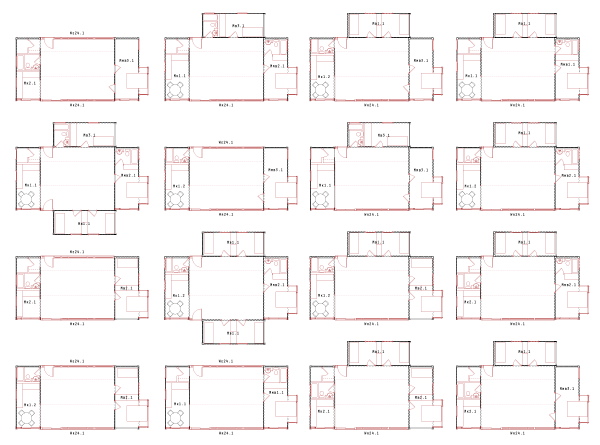 We will expand on this in future postings. We have larger house schema to show you. What we don't have yet is a clear path from here to your local IBU house store. Close advisors have told us: Don't let that stop you. Move the idea forward and the best method of delivery will emerge in the process. We are following their advice.
We will expand on this in future postings. We have larger house schema to show you. What we don't have yet is a clear path from here to your local IBU house store. Close advisors have told us: Don't let that stop you. Move the idea forward and the best method of delivery will emerge in the process. We are following their advice.
Technorati Tags: container house, modern design, modern house, modular house
Continue reading "LamiDesign IBU Building System - an advance look"
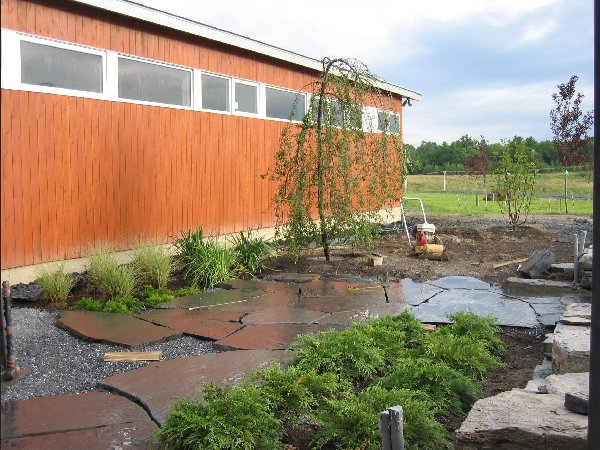 Although there are plants in place I understand that a landscape designer will be planting the garden. I'm not sure about the place-holders we see but I suspect the owner has planted them in the meantime.
Although there are plants in place I understand that a landscape designer will be planting the garden. I'm not sure about the place-holders we see but I suspect the owner has planted them in the meantime.
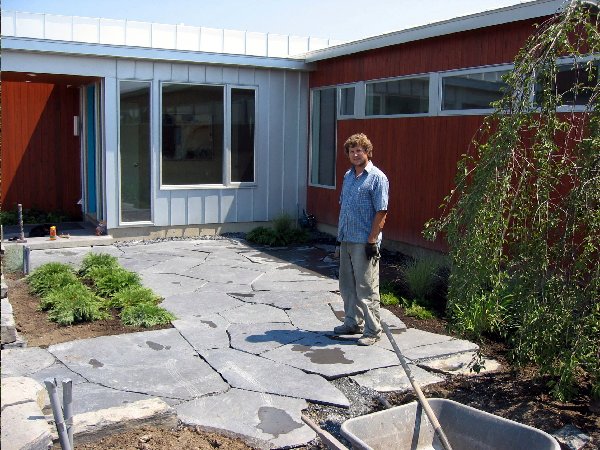 That's stone mason Dan Zimmer from Middlebury Vermont who has done the stone paving we see here as well as the dry set stone wall that borders the driveway. The owner designed the hardscape and Dan's done a great job with it.
That's stone mason Dan Zimmer from Middlebury Vermont who has done the stone paving we see here as well as the dry set stone wall that borders the driveway. The owner designed the hardscape and Dan's done a great job with it.

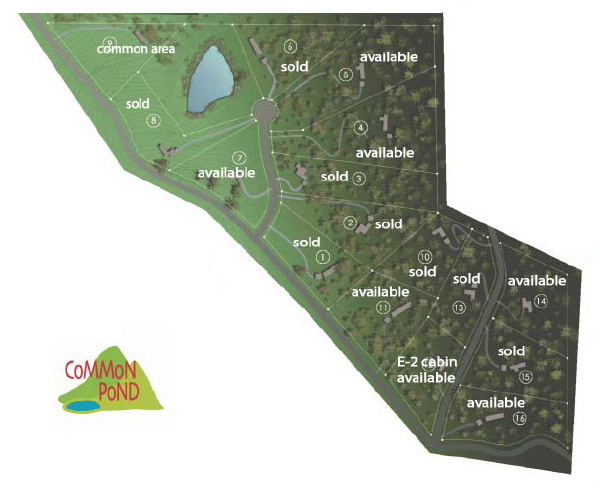 The house will be located on the slope approximately 125 ft from the lot line that borders the community common space around the pond. I'm quite sure the window and deck side of the house will be oriented towards this view and it should be a great setting.
The house will be located on the slope approximately 125 ft from the lot line that borders the community common space around the pond. I'm quite sure the window and deck side of the house will be oriented towards this view and it should be a great setting.
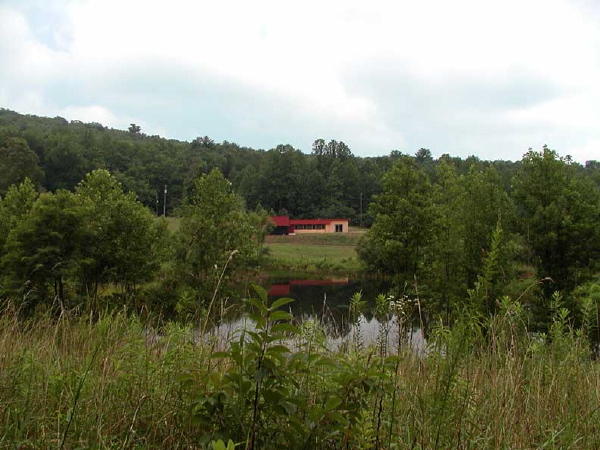 and the approach to the site:
and the approach to the site:
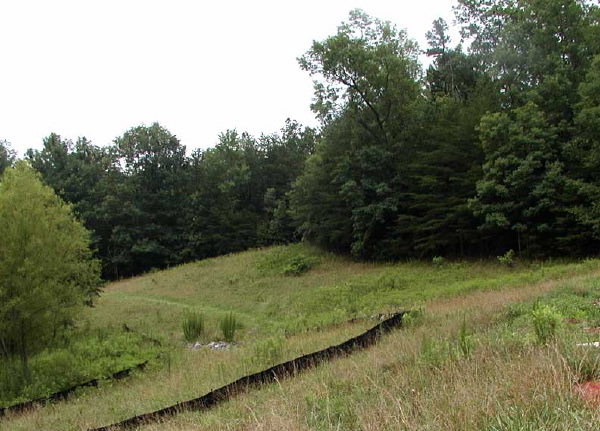 The clearing of the building site will begin soon. The developer and the owners have decided to construct this Plat House with SIPs panels to increase its energy efficiency and support the overall development goals of Common Pond. The SIPs manufacturer is working on the adaptation now. I'm excited to see this variation on the standard construction and look forward to seeing it come together here.
Common Pond is one of the few new modern communities I know of in the eastern half of the country. I've not seen any others that were built out as far as Common Pond is and I've seen no other modern development with the environmental mission that Common Pond has. Its great to see their success and I'm very happy that one of our home designs will become part of this community.
Visit these sites for more information:
The clearing of the building site will begin soon. The developer and the owners have decided to construct this Plat House with SIPs panels to increase its energy efficiency and support the overall development goals of Common Pond. The SIPs manufacturer is working on the adaptation now. I'm excited to see this variation on the standard construction and look forward to seeing it come together here.
Common Pond is one of the few new modern communities I know of in the eastern half of the country. I've not seen any others that were built out as far as Common Pond is and I've seen no other modern development with the environmental mission that Common Pond has. Its great to see their success and I'm very happy that one of our home designs will become part of this community.
Visit these sites for more information:
 At the site you can see the slab pour going in and the crew working feverishly to place the concrete while its workability is right. The "landscape" of the floor slab consists of several stub ups for plumbing, and recessed areas for shower tile setting beds, and the most prominent feature is the recessed area for the media room.
At the site you can see the slab pour going in and the crew working feverishly to place the concrete while its workability is right. The "landscape" of the floor slab consists of several stub ups for plumbing, and recessed areas for shower tile setting beds, and the most prominent feature is the recessed area for the media room.
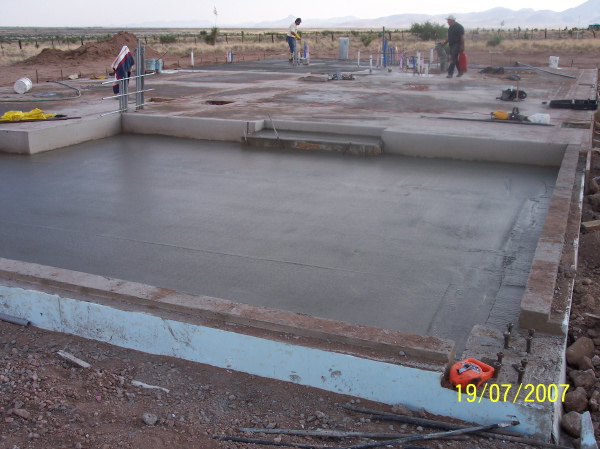 If you have not lived in a house with a slab on grade before, or have never seen one built it may come as a surprise that a good deal of work must happen before that goes down. There is just one chance to get it right, so things like plumbing drains which must go down are going to spend their life under a slab - inaccessible. That has to go in right the first time, and come up through the floor in exactly the right spot to correspond with the walls that will follow.
While they get ready for the arrival of the first steel parts we will look back at the most curious structure of the three - the observatory. The owner, an astronomy enthusiast, has had a very good quality instrument to work with, but always desired a fixed facility for an even more powerful instrument. This project was his opportunity to see that happen.
If you have not lived in a house with a slab on grade before, or have never seen one built it may come as a surprise that a good deal of work must happen before that goes down. There is just one chance to get it right, so things like plumbing drains which must go down are going to spend their life under a slab - inaccessible. That has to go in right the first time, and come up through the floor in exactly the right spot to correspond with the walls that will follow.
While they get ready for the arrival of the first steel parts we will look back at the most curious structure of the three - the observatory. The owner, an astronomy enthusiast, has had a very good quality instrument to work with, but always desired a fixed facility for an even more powerful instrument. This project was his opportunity to see that happen.
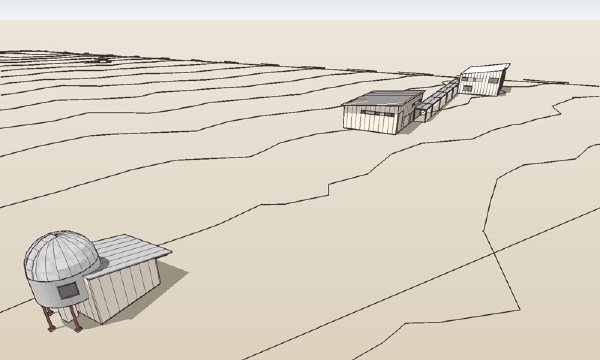 Working on this design was an education for us. I've always been interested in space and astronomy but never had a telescope. My brother and several friends have good telescopes but nothing that a consumer could not order from a catalog. This was different. The scope in this case is a precision instrument. It was going to be housed in a 16ft diameter dome with an operating aperture and motor driven base - just like the big boys. We did not have to design this - it is procured from a company that specializes in their fabrication. But we had to design up to it and support it. Adjacent to the dome is an equipment room. Here will reside computer equipment and tools and supplies to maintain the instrument. The computers control the tracking of the instrument, as well as manage image acquisition. You an use an eye-piece with the scope but the primary mode is a high res CCD capturing images and serving them to the operator who is remote. A web based interface allows for control as well as imaging so this is something that can be used where ever you have an internet connection. You do not need to be at the facility.
Working on this design was an education for us. I've always been interested in space and astronomy but never had a telescope. My brother and several friends have good telescopes but nothing that a consumer could not order from a catalog. This was different. The scope in this case is a precision instrument. It was going to be housed in a 16ft diameter dome with an operating aperture and motor driven base - just like the big boys. We did not have to design this - it is procured from a company that specializes in their fabrication. But we had to design up to it and support it. Adjacent to the dome is an equipment room. Here will reside computer equipment and tools and supplies to maintain the instrument. The computers control the tracking of the instrument, as well as manage image acquisition. You an use an eye-piece with the scope but the primary mode is a high res CCD capturing images and serving them to the operator who is remote. A web based interface allows for control as well as imaging so this is something that can be used where ever you have an internet connection. You do not need to be at the facility.
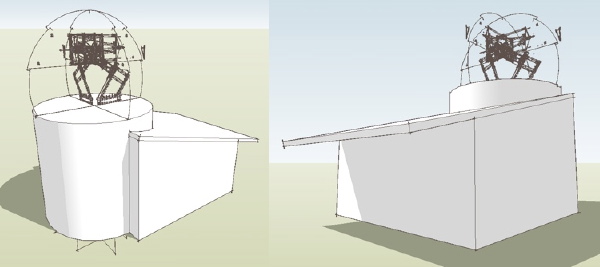 So we have these two parts - the equipment room which is conditioned for the electronics within. And the Dome which is not conditioned - it is intended to remain at ambient temperature so that when the dome is opened there is no thermal expansion or movement that would put the instrument out of calibration. We needed man access from the equipment room to the dome, as well as cargo access. So we have two hatches, one with a compact Lapeyre alternating tread stair, and the other clear for hoisting. The instrument lives within, elevated so that its pivot corresponds with the geometric center of the dome. It has its own foundation pillar which prevents any vibration of the building from transmitting into its mount.
So we have these two parts - the equipment room which is conditioned for the electronics within. And the Dome which is not conditioned - it is intended to remain at ambient temperature so that when the dome is opened there is no thermal expansion or movement that would put the instrument out of calibration. We needed man access from the equipment room to the dome, as well as cargo access. So we have two hatches, one with a compact Lapeyre alternating tread stair, and the other clear for hoisting. The instrument lives within, elevated so that its pivot corresponds with the geometric center of the dome. It has its own foundation pillar which prevents any vibration of the building from transmitting into its mount.
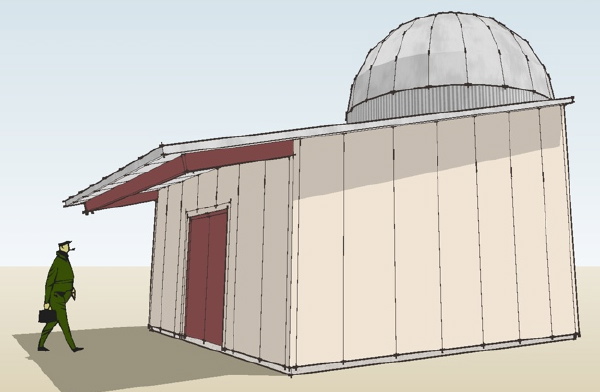 Once documented it underwent engineering and detailing in advance of its fabrication which is ongoing now.
Once documented it underwent engineering and detailing in advance of its fabrication which is ongoing now.
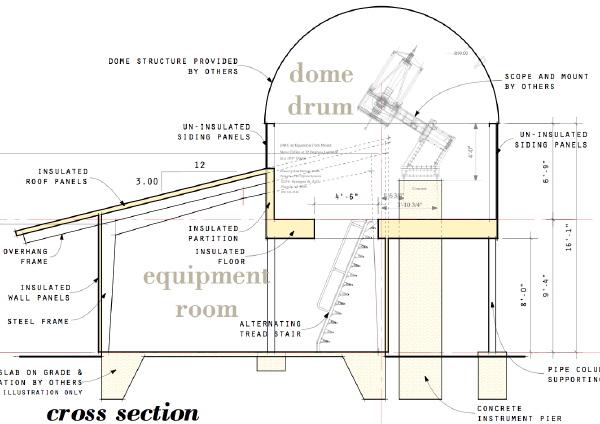 For the next update we should have the arrival of materials at the site.
For the next update we should have the arrival of materials at the site.
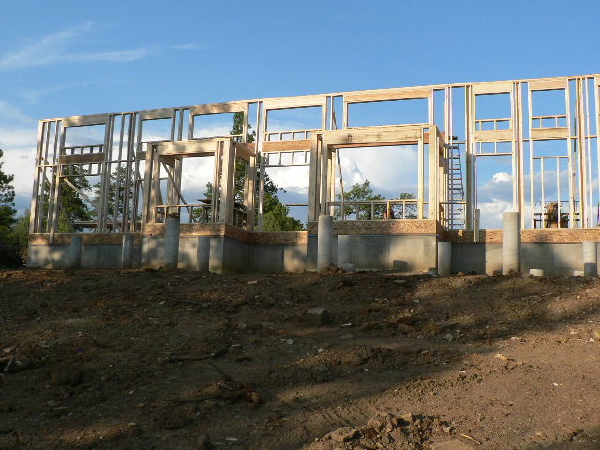 New photos of the construction progress from the owners shows the frame of the house going up quickly. Now that we have watched several
New photos of the construction progress from the owners shows the frame of the house going up quickly. Now that we have watched several 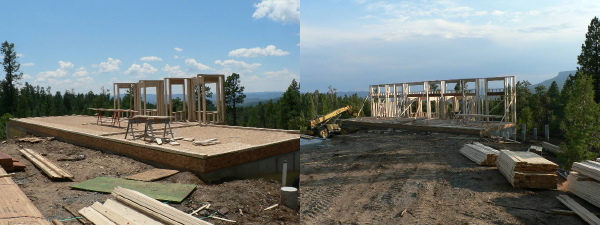 As was mentioned in a
As was mentioned in a 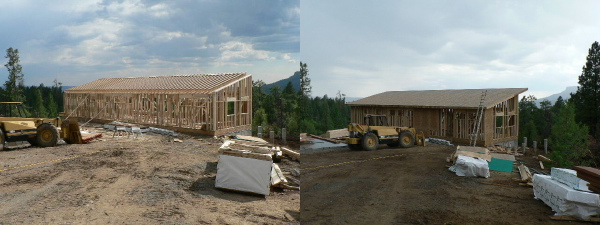 We can see that the corners of the bay windows have been made wider. This may have been to strengthen them for load, or to reduce the window area for energy concerns. We can also see that the side overhangs have been greatly reduced. This is to be expected as the stock design has a deep side overhang that would be difficult to cantilever with a high snow loading.
We can see that the corners of the bay windows have been made wider. This may have been to strengthen them for load, or to reduce the window area for energy concerns. We can also see that the side overhangs have been greatly reduced. This is to be expected as the stock design has a deep side overhang that would be difficult to cantilever with a high snow loading.
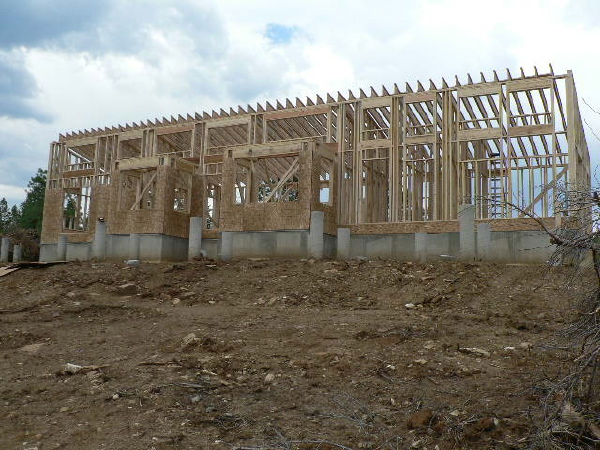 These adjustments are necessary and desirable. Not only do they ensure that your house performs as it needs to, but it differentiates your house from the stock design and makes it more your own. Much thanks to our Colorado Owners for sharing their build.
These adjustments are necessary and desirable. Not only do they ensure that your house performs as it needs to, but it differentiates your house from the stock design and makes it more your own. Much thanks to our Colorado Owners for sharing their build.

 The bedrooms are very small by today's standards. The bathrooms are as well - 5x7s as they are known in the industry. Yet the living room at 20ft by 24ft is larger than what is offered in many larger homes. This small house will live larger than its size no doubt, but the proximity of living space to bedrooms will not allow you to escape the fact it is a small home.
But this one layout is only the start. We intend to offer a small range of modules with slightly different configurations in order to allow you to find a combination that best suits your needs. In the image you can see there are 3 different Kitchen modules shown, and 3 different Master Bedroom modules, and 3 different modules for secondary bedrooms. These units can be plugged and played to create new variations on the floor plan, albeit subtle variations. However 2 box variations on the schema are possible for even smaller 1 or 2 bedroom homes, or 4 box variations which can create 4 or 5 bedroom homes.
The depth of variation that these modules introduces grows quite quickly. Below we have shown 16 floor plan variations of the 24 which we quickly came up with. I am sure there are many more that have not occurred to us yet. We expect our customers to surprise us with the variations they bring to the table.
The bedrooms are very small by today's standards. The bathrooms are as well - 5x7s as they are known in the industry. Yet the living room at 20ft by 24ft is larger than what is offered in many larger homes. This small house will live larger than its size no doubt, but the proximity of living space to bedrooms will not allow you to escape the fact it is a small home.
But this one layout is only the start. We intend to offer a small range of modules with slightly different configurations in order to allow you to find a combination that best suits your needs. In the image you can see there are 3 different Kitchen modules shown, and 3 different Master Bedroom modules, and 3 different modules for secondary bedrooms. These units can be plugged and played to create new variations on the floor plan, albeit subtle variations. However 2 box variations on the schema are possible for even smaller 1 or 2 bedroom homes, or 4 box variations which can create 4 or 5 bedroom homes.
The depth of variation that these modules introduces grows quite quickly. Below we have shown 16 floor plan variations of the 24 which we quickly came up with. I am sure there are many more that have not occurred to us yet. We expect our customers to surprise us with the variations they bring to the table.
 We will expand on this in future postings. We have larger house schema to show you. What we don't have yet is a clear path from here to your local IBU house store. Close advisors have told us: Don't let that stop you. Move the idea forward and the best method of delivery will emerge in the process. We are following their advice.
We will expand on this in future postings. We have larger house schema to show you. What we don't have yet is a clear path from here to your local IBU house store. Close advisors have told us: Don't let that stop you. Move the idea forward and the best method of delivery will emerge in the process. We are following their advice.
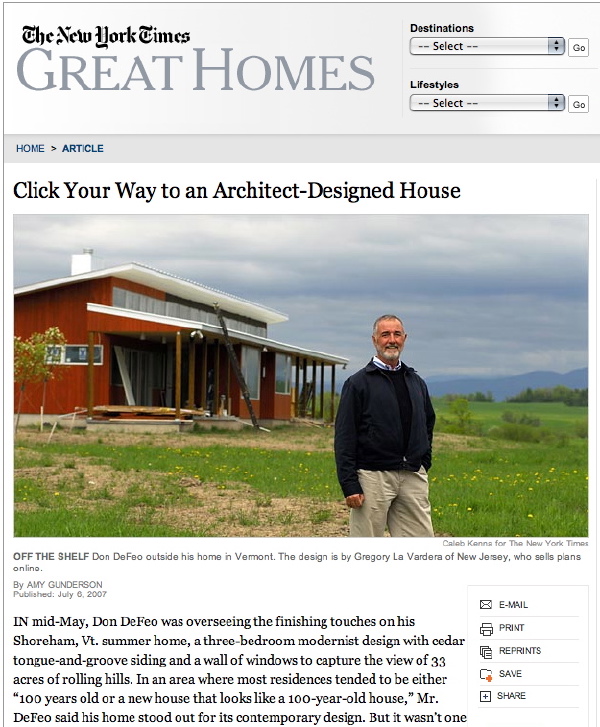
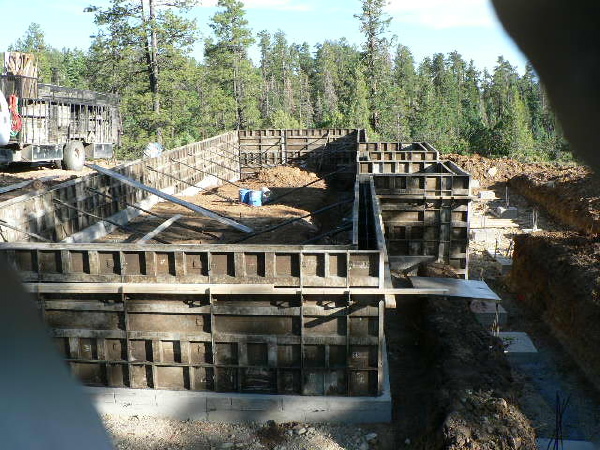 Poured concrete foundation wall, or concrete block? This is a frequent question. If concrete block is common for foundation walls in your region then it is often less expensive. If not, then it will likely be comparable in cost to concrete. The end result is concrete is often a superior foundation wall and when properly reinforced it can often be narrower than concrete block of equal strength. The poured concrete is much less porous than the concrete masonry units and can create a more water tight basement or crawl space. A concrete pour is faster, but the formwork is an additional step that will make the overall install time comparable. If the cost is the same then choose concrete.
Poured concrete foundation wall, or concrete block? This is a frequent question. If concrete block is common for foundation walls in your region then it is often less expensive. If not, then it will likely be comparable in cost to concrete. The end result is concrete is often a superior foundation wall and when properly reinforced it can often be narrower than concrete block of equal strength. The poured concrete is much less porous than the concrete masonry units and can create a more water tight basement or crawl space. A concrete pour is faster, but the formwork is an additional step that will make the overall install time comparable. If the cost is the same then choose concrete.
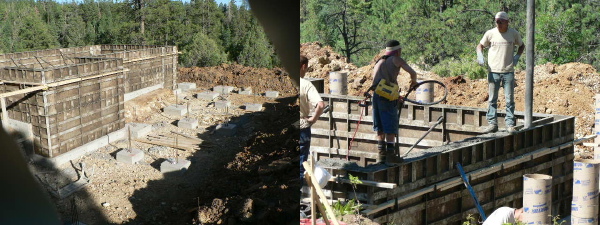 That yellow shoulder pack appears to be a concrete vibrator, although I've never seen one so small before. This does as it implies - vibrates the concrete which promotes it settling into all the nooks and crannies of the formwork and reinforcing bars, and sends air bubbles to the top.
That yellow shoulder pack appears to be a concrete vibrator, although I've never seen one so small before. This does as it implies - vibrates the concrete which promotes it settling into all the nooks and crannies of the formwork and reinforcing bars, and sends air bubbles to the top.
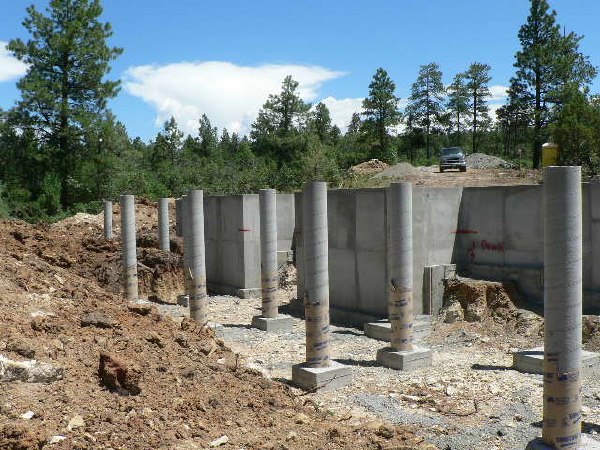 And here it is cured and forms stripped. You can clearly see the two bay window areas and the foundations for the deck. They look like tall piers here, but I'm quite sure that there will be back fill that brings the deck down closer to grade.
And here it is cured and forms stripped. You can clearly see the two bay window areas and the foundations for the deck. They look like tall piers here, but I'm quite sure that there will be back fill that brings the deck down closer to grade.
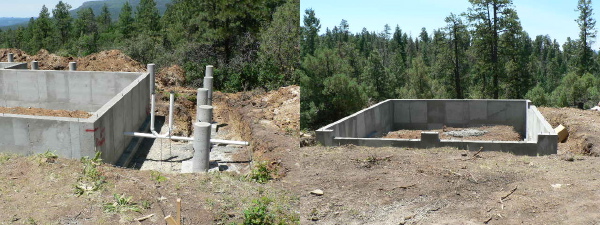 And here you can also see that they have created a small garage for themselves. There is no garage in the plan set so we know that the customer and contractor are jumping off of the house design for the garage. I love that and I can't wait to see how it turns out.
And here you can also see that they have created a small garage for themselves. There is no garage in the plan set so we know that the customer and contractor are jumping off of the house design for the garage. I love that and I can't wait to see how it turns out.
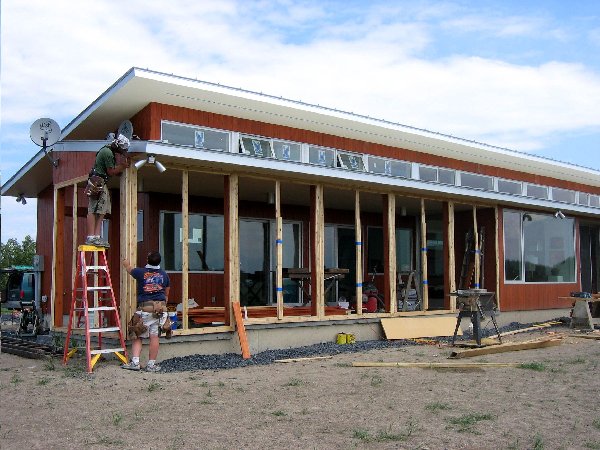 This is the screened porch off of the guest bedrooms. It is also accessed directly from the living room. There are still a lot of window stickers to be removed and it looks like the satellite down-link is in place!
This is the screened porch off of the guest bedrooms. It is also accessed directly from the living room. There are still a lot of window stickers to be removed and it looks like the satellite down-link is in place!


